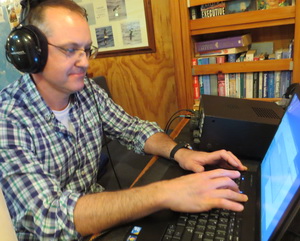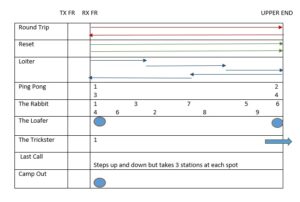
How to Get in the VK0EK Log (Pt. 10): Working Split and LISTENING
Top Band Award Winner Vadym, UT6UD
The seasoned DXer has been in so many pileups that she knows the “usual patterns” that the DXpedition station uses to try to “thin out the herd” or spread out the callers so they can be heard (on Heard). This seasoned DXer gets in the log the first day the DX is on – and while the antenna is very important, (power less so) – operating skill is perhaps the most important part of the DXing equation.
First lets list the three “prerequisites”:
- VK0EK WILL ALWAYS WORK SPLIT. NEVER SIMPLEX.
(Split means they transmit on one frequency and receive on another that is usually a range of frequencies above or below where they are transmitting. Simplex means they would transmit and receive On The Same Frequency – and VK0EK will NEVER do this.) If you transmit on the same frequency – you will actually get yelled at and otherwise scorned by hundreds or thousands who are listening to the DXpeditions transmission – and they get angry when someone transmits on the DXpeditions frequency who is other than the Dxpedition operator. - LISTEN. WATCH FOR THE OPERATORS “PATTERN” BEFORE YOU START CALLING.
- STUDY AND MEMORIZE THE BAND PLAN LISTED IN THE PLAN SECTION OF THIS WEB SITE. WHEN FT4JA IS ON THE AIR WE WILL USE THE COORDINATED BAND PLAN. IF YOU HAVE QUESTIONS PLEASE CLICK ON “CONTACT US” ON THIS WEB SITE OR ON DXA
I always wondered exactly what all of the “usual” instructions are for DXers. They always say “Listen, Listen and Listen some more”. The problem with some of these articles, treatises and tomes is that they don’t tell you what to listen for exactly, and for how long. So – I will make an attempt to visually show you what to listen for – the DXpeditions operators pileup patterns. The quicker you can “get this”, the quicker you can get in the log.

The TX FR is where the DXpedition is transmitting, the RX FR is where the DXpedition is listening for the low end of a range up to a maximum top end listed as UPPER END in the above graphic
The “Round Trip” pattern is where the DXpedition operator goes up from the bottom frequency he is listening on and then slowly “walking” up to the top end of the frequency range. Then he comes back down. This is the classic and one of the most methodic methods.
The “Reset” is where the operator goes from lowest frequency in her range to top end of her range, then “resets” back down to the lower end and climbs back up. Another very methodical and predictable pattern.
The “Loiter” is a lot like the “Round Trip”, but the operator might decide to “linger” on each stop for several stations.
The “Ping Pong” might have the operator jumping methodically between a low and high frequency in the range.
The “Rabbit” hops all over the place and is totally unpredictable.
The “Loafer” says they are listening in a range but goes back and forth between 2 frequencies and hangs out at each as long as they can still run the pileup.
The “Trickster” might occasionally go above or below the range that the operator announces when they say something like “Up 5 – 15”.
The “Last Call” is some variation on the Loiter.
The “Camp Out” happens a lot on 40M SSB – where the DXpedition op targets a part of the world and sets a specific frequency – sometimes where say these two areas are not allowed on the specified frequency for that part of the world. This happens a lot where NA and JA’s have propagation and the op wants to separate these areas.
So – the answer to the question of what to listen for is a PATTERN. And if you only spend 5 minutes just listening to the pileup before you start wailing away with your transmitter, the sooner you will get in the log. There are other patterns too – but this is all meant to give you an idea. There are certainly debates on what is best practice or not – but as a DXer, these are the ones I remember clearly. Good or bad – when I’m chasing the DXpedition – they call the shots and I have to follow their lead. Else – we step on each others toes and I get no Q.
GUARANTEED!
Jon, N0JK wrote in to remind us:
Another tip is if you are not sure the DX station has your call correct, don’t send just “599.” Send your call, then the report.
100% agree on that!
This concludes my series on How to Get in the VK0EK Log, and I would love to hear if anything in this series has helped you – either while you prepare in these last days before VK0EK is on the air – or perhaps after you snag a Q with the team.
